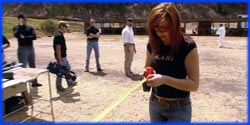


Premier Date: April 13, 2011
busted
Adam and Jamie began by placing magazines of various thicknesses in toasters and timing how long they took to catch fire. The thinnest and fastest to burn, similar to common newsprint or comic books, took roughly 2 minutes to catch a flame rather than the 20-30 seconds observed in the film. Small-scale tests with mixtures of methane and air indicated that a methane level as low as 6% (the bottom end of its flammability range) could trigger a noticeable explosion.
For full-scale testing, they built a replica of Jason Bourne’s apartment, including the toaster, magazine, and methane supply. Their first attempt at an explosion, using the circumstances shown in the movie, did not give any significant reaction, and the myth was declared busted. A second attempt with a higher gas concentration and a fireplace starter log as the ignition source led to an energetic fire, but no explosion. Adam and Jamie made one last attempt, using enough methane to achieve a 9% concentration (the center of the flammability range) and a set of fans and diffuser hoses to mix the gas and air thoroughly. This time, they were able to get one wall to blow out and set the apartment on fire.
confirmed
To set the stage for this myth, Kari spoke to an airplane technician and learned that although a pilot cannot dump the toilet mid-flight, the contents could leak out if multiple valves and seals failed.
For their tests, the Build Team made a small section of an airplane fuselage, including a lavatory service outlet (designed to suffer a slow or sudden leak, as needed). They took this rig to a wind tunnel at NASA designed for high-altitude simulation (including low air-temperature). When the toilet was dumped all at once, the fluid quickly atomized in the wind, leaving only a thin film to freeze on the fuselage. However, a slow leak allowed the ice to build up into a large mass that did not break loose until the rig “descended” (i.e. the air temperature in the wind tunnel was increased) to 12,000 feet (3,650 meters).
To determine the ability of such a chunk of ice to survive a fall to earth, Kari dropped a 35-pound (16 kg) block of ice from an airplane at 12,000 feet. Grant and Tory tracked it from the ground while Kari skydived. The block remained intact and embedded itself deeply upon impact, prompting the team to declare the myth confirmed, although unlikely due to the multiple mechanical failures needed to achieve the result.
Previous: Episode 160: Mission Impossible Mask